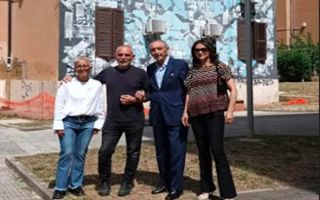(Finance) – In the morning of Sunday 16 June, in Tor Marancio, the event was inaugurated “Rome sweet home. Living in the Capital“, created by the Museum of the Suburbs directed by Giorgio de Finis in collaboration with the Tormararte Association chaired by Cristina Giuliani, with the patronage of the VIII Municipality of the Municipality of Rome and the contribution of the Terzo Pilastro Foundation – Internazionale, previously chaired by Prof Lawyer Emmanuele FM Emanuele and currently led by Prof. Alessandra Taccone.
The project takes shape in four photographic routes of as many photographers (Franco Buoncristiani, Aldo Feroce, Francesca Romana Guarnaschelli, Fabio Moscatelli), which tell about places and forms of living in the capital: Corviale, Tor Bella Monaca, Metropoliz and its inhabited museum, the villages and small villas around the GRA. A portrait of today’s Rome which is hosted in the condominium stairs of the Tor Marancio complex, a short circuit to connect apparently distant points of the city, but linked by the common question of housing.
A performance by the innocent artists “Constanza Zimmer” welcomed the public present at the inauguration. Present at the event, among others, was the President of the Terzo Pilastro Foundation, Prof. Alessandra Taccone, who commented as follows: “The Terzo Pilastro Foundation – International, of which I am honored to be President – having inherited with pride and gratitude this prestigious and important role by Prof. Avv. Emmanuele FM Emanuele, who today grants me the privilege of being here with me – could not fail to actively contribute to this event, which aims to enhance, enrich and further promote this happy experience of an “air museum “open” created in 2015, by will of the then President Prof. Emanuele, by the Roma – Arte – Musei Foundation in collaboration with the 999 Contemporary Gallery, together with Roma Capitale and ATER of the Municipality of Rome”.
The initiative mentioned, entitled “Big City Life”, created on the initiative of Prof. Emanuele almost ten years ago, is significant from both an artistic and social point of view: as regards the first aspect, it resulted in the creation of 18 monumental street-art works on the facades of the 11 buildings belonging to Lot 1 of Tor Marancio, the result of preliminary meetings between internationally renowned artists (such as Seth, Mr. Klevra, Diamond, Vhils, Gaia, just to name a few) and the local community. But it was equally important and significant from a social point of view, as it made the inhabitants of the neighborhood actively protagonists from the beginning, who have, in fact, become the guardians and main promoters of the territory, safeguarding and enhancing it with a constant and systematic intervention.
The extraordinary success achieved by this real “condominium museum”, and the commitment and passion lavished on its care by the inhabitants of Tor Marancio, had as a natural consequence the succession of other side projects, convincedly supported by the Third Pillar Foundation also through the Culture and Art Foundation. In particular, the initiative “Tor Marancio 2.0” of 2018, created in collaboration with the Shanghai Open-Air Museum association in Tor Marancio (MAST 35), thanks to which new signs were created for the museum itinerary, the installation and implementation of the captions of the works carried out on homes, various maintenance interventions and the digitalisation of the exhibition itinerary, introducing new technologies such as the QR Code and a dedicated smartphone application.
At the same time as the creation of the “Tor Marancio 2.0” app by the Culture and Art Foundation, the Terzo Pilastro Foundation – thus confirming its vocation for intervention in favor of the less fortunate – intervened, again at the specific interest of Prof. Emanuele, to equip building F in the Viale Tormarancio n. 63/A of an elevator, built by Marrocco Elevators Srl, to allow a young disabled tenant to be able to go up and down freely from his apartment, allowing him to participate fully in the life of the neighborhood.
Again, in 2021, the Culture and Art Foundation, on the occasion of the establishment of the Tormararte cultural association (created to enhance the murals created in the housing complex), contributed to the creation of a series of events, including: an experiential artistic workshop, intended for a group of students aged between 10 and 14; a debate on the very current theme of “The concept of copyright applied to street art”, with the participation of artists and exponents of the cultural world; the inauguration of a small library for children.
The Prof. Attorney Emmanuele FM Emanuele, philanthropist and patron, former President of the Terzo Pilastro Foundationwho also participated in the inauguration, concluded as follows: “I am very happy to have contributed to realizing this initiative in Tor Marancio, in this wonderful place where I feel at home, surrounded by the affection of all the inhabitants of the neighborhood and the institutions of Municipality VIII. This is also in consideration of the fact that one of my constant objectives is the redevelopment of the suburbs, which are increasingly protagonists of the contemporary urban artistic panorama and capable of making art immediately accessible to every single citizen. In my opinion, this is a very important event from a cultural point of view, in a country where, despite the fact that it has been estimated that our artistic and landscape heritage is worth 120% of the Gross Domestic Product, the State does not believe in the economic importance of culture, allocating only a minimal part of GDP to it, i.e. 0.2%. The private foundations belonging to the Third Sector – such as the one that I was honored to preside over and which is today worthily led by Prof. Taccone – are the entities that do their utmost more than anyone else for the development and diffusion of culture, and for the protection of our priceless artistic and landscape heritage, on the basis of my long-standing assumption that Culture is the privileged tool for breaking down social, economic, racial and religious barriers”.
